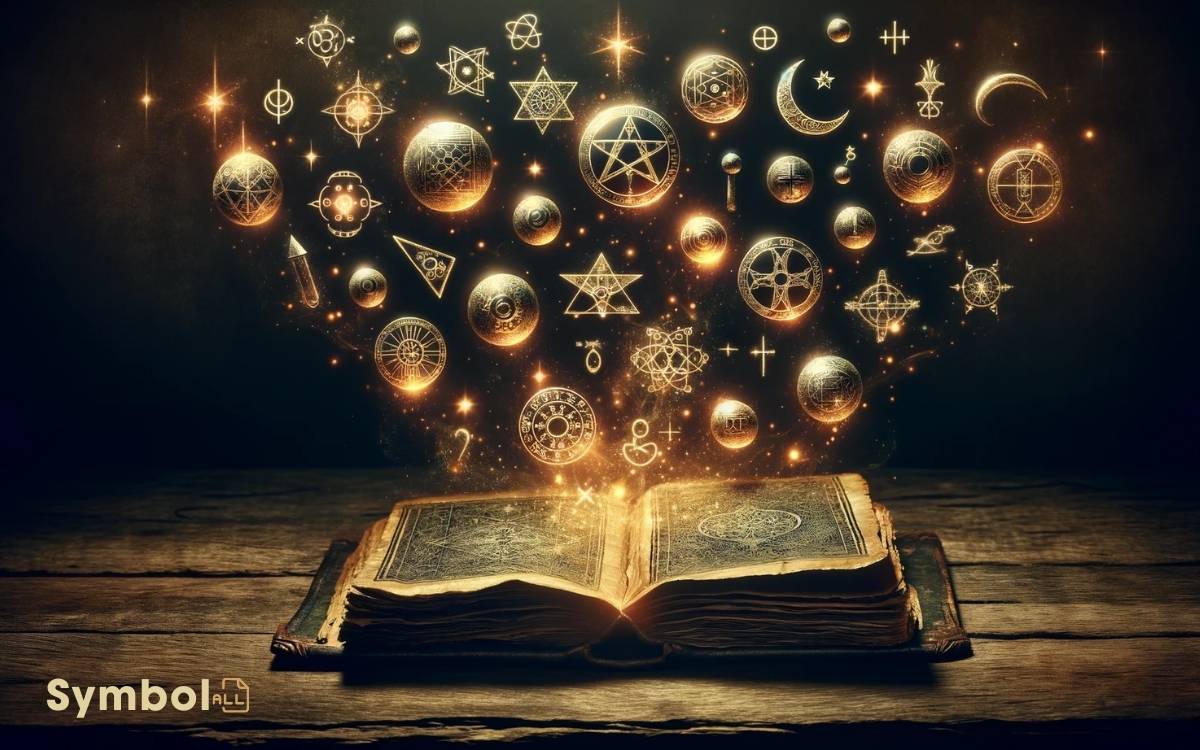How to Use Alchemy Symbols? Explains!
To use alchemy symbols effectively, you’ll first need to grasp their inherent meanings. Each symbol be it the Ouroboros denoting cyclicality or basic elements like earth, air, fire, and water carries profound philosophical and material properties.
These symbols serve as a framework for exploring the interconnectedness of the cosmos, nature, and the human spirit.
Start by aligning symbols with your personal goals and the transformations you seek. In meditation, place symbols within your visual field, allowing their energies and meanings to guide your focus.
By incorporating these symbols into your practice, you reveal insights into transformational processes. Essentially, these symbols offer a rich tapestry for personal and collective growth, promising deeper understandings with further exploration. By engaging with these symbols and archetypes in literature, you unearth universal themes that resonate across time and cultures, bridging the collective unconscious with individual experience. This interconnectedness not only enriches one’s interpretative framework but also fosters an appreciation for the enduring power of storytelling. In doing so, these symbols become tools for navigating the complexities of life, offering clarity and meaning amidst transformation.

Key Takeaways
Understanding Alchemy Symbols
To fully understand the intricacies of alchemy symbols, it’s important to explore their historical origins and symbolic meanings, which have deeply impacted both ancient and modern scientific and philosophical thought.
Each symbol in alchemy represents a concept, element, or process fundamental to the transformational practice be it physical, spiritual, or both.
You’ll find that symbols like the Ouroboros, an ancient depiction of a serpent eating its own tail, convey notions of cyclicality and eternal return, essential to the alchemist’s quest for renewal and enlightenment.
Similarly, the square, circle, and triangle illustrate the alchemists’ pursuit of material and spiritual harmony, symbolizing the four elements, the universe, and the tria prima, respectively.
Grasping these symbols’ layered meanings offers you a window into the alchemists’ worldview, revealing a rich tapestry of interconnectedness between the cosmos, nature, and the human spirit.
The History of Alchemy
You must appreciate that the origins of alchemy are shrouded in a rich tapestry of history and mysticism, emerging as a precursor to modern chemistry.
Its metamorphosis from esoteric practices to a foundational scientific discipline underscores a transformative journey through civilizations.
This evolution highlights not only the accumulation of knowledge but also the changing perceptions of matter and the universe.
Origins of Alchemy
Alchemy’s origins stretch back to ancient times, where it was practiced as a blend of science, philosophy, and mysticism, aiming to transform base metals into noble ones, discover a panacea, and achieve immortality.
This pursuit wasn’t merely materialistic; it was deeply intertwined with the spiritual and the philosophical. Alchemists believed in the interconnectedness of all elements in the universe, positing that a single, universal substance could be manipulated through their processes.
Key aspects of ancient alchemy include:
- The pursuit of the philosopher’s stone
- The concept of transmutation
- The symbolic use of alchemical imagery
- The integration of hermetic principles
- The quest for spiritual enlightenment
You’ll find that understanding these foundational ideas provides invaluable context for the symbols and practices that later alchemists developed, further enriching your grasp of this ancient discipline.
Evolution Into Chemistry
Understanding the foundational principles and practices of ancient alchemy sets the stage for examining how these early mystical endeavors eventually evolved into the modern science of chemistry.
You’ll find that alchemy’s quest to transform base metals into noble ones, alongside the pursuit of the philosopher’s stone, laid the groundwork for systematic experimentation.
This relentless experimentation fostered a methodology that, over centuries, shifted from speculative to empirical.
Alchemists’ meticulous documentation of their processes, despite their mystical goals, unwittingly paved the way for the scientific method. It’s important to recognize that the change wasn’t sudden but a gradual refinement of alchemical practices.
As you explore further, you’ll appreciate how alchemy’s symbolic language and transformative aspirations were catalysts for the birth of chemistry, a discipline grounded in observation, experimentation, and rational analysis.
Basic Alchemical Elements
As you advance in your comprehension of alchemy, it’s essential to grasp the foundational symbols representing the basic alchemical elements.
These symbols not only encode the essence of the elements they depict but also serve as a bridge to interpreting their broader metaphysical and practical roles in various alchemical processes.
Elemental Symbols Overview
In the domain of alchemy, four primary elements earth, air, fire, and water serve as the foundational symbols, each embodying distinct philosophical and material properties.
These elements aren’t merely physical substances but represent the intricate balance and interplay that governs both the natural world and the spiritual sphere.
They’re pivotal in understanding alchemical processes, embodying principles that transcend mere chemical reactions.
- Earth symbolizes stability and physicality.
- Air represents intellect and communication.
- Fire is associated with transformation and energy.
- Water embodies intuition and emotion.
Collectively, they illustrate the complexity of alchemical thought, emphasizing a holistic approach to both material and spiritual pursuits.
These elements are integral to grasping the broader implications of alchemical symbolism, serving as a fundamental framework for deeper exploration into this ancient practice.
Interpreting Common Elements
Delving deeper into the domain of alchemy, you’ll find that the basic elements earth, air, fire, and water aren’t just symbols; they’re keys to unraveling the mysteries of transformation and the fundamental principles of the universe.
Earth symbolizes stability and physicality, grounding your alchemical work in the tangible world. Air, in contrast, represents intellect and communication, facilitating the exchange of ideas and the refinement of thoughts.
Fire, with its transformative power, embodies change, passion, and purification, essential for the alchemist’s pursuit of enlightenment and transmutation.
Finally, water signifies intuition, emotional insight, and adaptability, essential qualities for exploring the fluid and often uncertain processes involved in alchemy.
Understanding these elements in their symbolic and practical dimensions allows you to harness their energies effectively, laying the groundwork for deeper explorations into alchemical practice.
Practical Symbol Applications
Understanding the basic alchemical elements earth, air, fire, and water provides a foundation for their practical application in transformative practices and rituals.
Each element symbolizes a different aspect of the natural and spiritual spheres, enabling you to harness their energies effectively.
By integrating these symbols into your daily life, you’re engaging in a form of spiritual alchemy aimed at personal transformation and enlightenment.
- Earth symbolizes stability and fertility, grounding your energy.
- Air represents intellect and communication, enhancing your cognitive abilities.
- Fire embodies passion and creativity, fueling your ambitions.
- Water signifies emotions and intuition, deepening your emotional intelligence.
- Quintessence (sometimes considered the fifth element) symbolizes the spirit or the essence of being, connecting you to the spiritual domain.
Mastering these symbols allows for a nuanced understanding of the interconnectedness of the physical and spiritual universes, guiding you towards a balanced and harmonized existence.
Interpreting Symbol Meanings
To accurately interpret alchemy symbols, one must explore the historical and cultural contexts from which they originate.
Each symbol encapsulates not just an element or process but also philosophical concepts, spiritual beliefs, and the alchemists’ quest for knowledge.
You’ll find that symbols like the Ouroboros, representing infinity and the cyclical nature of the universe, carry layers of meaning that require a thorough investigation into ancient texts and interpretations.
Understanding the emblematic language of alchemy involves recognizing that these symbols weren’t arbitrary but chosen with intention to convey complex ideas about the material and spiritual worlds.
Approaching their study diligently, examining the multifaceted meanings attributed to them throughout history, is crucial to grasp their true significance and application.
Symbols of Transformation
In exploring symbols of transformation within alchemy, you’ll uncover the profound principles of alchemical transmutation. This journey necessitates a detailed understanding of elemental symbols, which serve as the foundation for interpreting transformative processes.
Alchemical Transmutation Principles
Alchemical transmutation, often symbolized through intricate symbols, represents the core process of turning base materials into noble ones, a principle deeply embedded in the fabric of alchemical practice.
This transformation isn’t merely physical but also spiritual, indicating a journey of purification and enlightenment. As you explore further, you’ll find that alchemical symbols for transmutation aren’t just literal but embody profound metaphysical and philosophical truths.
Symbols denote stages of transformation: dissolution, purification, coagulation, fermentation, and projection.
- Each stage symbolizes a phase in the alchemist’s personal and spiritual development.
- The process mirrors the internal quest for wisdom and enlightenment.
- Transmutation symbols are guides, offering insights into the alchemist’s path.
- Understanding these symbols requires not only intellectual grasp but intuitive insight.
In this light, alchemy transcends its historical roots, offering a timeless guide to personal transformation.
Elemental Symbols Explained
Exploring the domain of elemental symbols, you’ll uncover they serve as fundamental markers of transformation within the alchemical tradition, each embodying specific energies and processes essential to the art of turning base materials into noble ones.
These symbols Earth, Air, Fire, Water, and the quintessential Aether aren’t merely representations of physical elements but are deeply interwoven with spiritual and metaphysical principles.
Earth symbolizes stability and growth; Air denotes intellect and communication; Fire signifies transformation and creation; Water represents intuition and emotion, while Aether, often less mentioned, embodies the pure essence that transcends the tangible.
Understanding these symbols isn’t just about recognizing shapes; it’s about delving into their intrinsic meanings, allowing alchemists to harness their energies in pursuit of enlightenment and the transmutation of matter.
Incorporating Symbols Into Rituals
Many practitioners find that incorporating alchemy symbols into rituals can significantly enhance the spiritual or transformative experience by providing a focused energy that aligns with their intentions. The precise application of these symbols is crucial for their effective use.
Understanding the historical and metaphysical significance behind each symbol allows for a deeper connection and more potent ritual.
Consider the following when integrating symbols into your practices:
- Intentionality: Choose symbols that resonate with your specific goals.
- Placement: Consider the spatial arrangement of symbols within your ritual space.
- Combination: Analyze how different symbols interact and complement each other.
- Consecration: Treat each symbol with respect, perhaps dedicating it in a small ceremony.
- Reflection: After the ritual, contemplate on the symbol’s influence and your experience.
This approach guarantees a thoughtful and powerful application of alchemy symbols in your rituals.
Alchemy in Modern Practices
While the previous section highlighted the importance of incorporating alchemy symbols into rituals, we now focus on the broader application of alchemy in contemporary spiritual practices.
Alchemy’s principles, once confined to esoteric circles and cryptic texts, have permeated modern spirituality, offering a rich tapestry of symbols and metaphors for personal transformation.
You’ll find alchemy’s influence in mindfulness practices, where the transformation of base thoughts into enlightened awareness mirrors the alchemical goal of transmuting base metals into gold.
Additionally, in therapeutic settings, alchemical symbolism serves as a powerful tool for psychological introspection and healing, guiding individuals through the process of confronting and integrating their shadow selves.
This integration of alchemy into modern practices underscores its enduring relevance and adaptability, demonstrating its potential to foster profound personal and collective growth.
Creating Personal Alchemy Symbols
In the journey towards personal transformation, creating your own alchemy symbols can serve as a profound method of self-expression and introspection.
This creative process not only allows you to explore into the depths of your unconscious but also to manifest your desires and aspirations in a tangible form.
When designing your symbols, consider:
- Your personal goals and what you wish to transform or manifest
- Symbols from nature that resonate with you
- Colors that evoke certain feelings or energies
- Geometric shapes that hold specific meanings for you
- Historical alchemical symbols that you feel drawn to
Symbols for Healing and Protection
How can symbols specifically crafted for healing and protection enrich your journey towards self-empowerment and resilience?
In the domain of alchemy, these symbols aren’t merely decorative; they embody a profound synthesis of metaphysical principles and psychological insights.
Each symbol serves as a focal point, channeling your intent and amplifying your innate capacity for self-healing and warding off negative influences.
The Philosophers Stone Explained
Embarking on an investigation of the Philosopher’s Stone reveals its function as not just a legendary element, but a symbol deeply rooted in the pursuit of transformation and enlightenment within the domains of alchemy.
This enigmatic stone symbolizes ultimate wisdom and the alchemist’s quest for the elixir of life and the transmutation of base metals into gold.
Its significance spans across:
- Spiritual transformation
- Physical and metaphysical healing
- Immortality and eternal youth
- Unity of opposites
- Alchemical magnum opus
Understanding the Philosopher’s Stone requires you to explore the symbolic language of alchemy, interpreting its hidden meanings beyond the literal. It’s a complex emblem of the alchemist’s aspirations towards perfection, both materially and spiritually.
Its study offers insight into the profound depths of alchemical thought and the universal quest for knowledge and self-improvement.
Alchemical Symbols in Art
Alchemical symbols permeate art history, serving as intricate vessels of esoteric knowledge and philosophical insights.
You’ll find that artists have historically embedded these symbols within their works, not just for decoration, but to convey deep, often hidden meanings.
These symbols, ranging from the simple representation of elements to complex compositions, illustrate the artist’s engagement with alchemical principles and the transmutation of the soul.
| Symbol | Significance in Art |
|---|---|
| Ouroboros | Represents the cyclical nature of the universe, embodying the concept of eternity and the continuous cycle of life, death, and rebirth. |
| Alchemical Gold | Symbolizes perfection, enlightenment, and the ultimate goal of the magnum opus. |
| Phoenix | Depicts transformation, rebirth, and the triumph of spirit over matter. |
Understanding these symbols enriches your appreciation of art, revealing layers of meaning that transcend the purely aesthetic.
Enhancing Meditation With Symbols
Incorporating symbols into your meditation practice can profoundly deepen the experience by engaging both the conscious and subconscious mind.
By carefully selecting alchemy symbols that resonate with your personal goals and intentions, you create a focused environment conducive to profound introspection and transformation.
Alchemy symbols serve as powerful tools for visualization, concentration, and the manifestation of desired outcomes.
Consider the following when integrating symbols into your practice:
- Choose symbols aligning with your intentions.
- Place symbols within your visual field during meditation.
- Visualize the symbol’s meaning and energy.
- Use the symbol to guide your breath and focus.
- Reflect on insights or feelings that arise post-meditation.
This analytical approach enhances the meditation experience by leveraging the symbolic power inherent in alchemical imagery, fostering a deeper connection to the psychological and spiritual dimensions of the self.
Resources for Further Learning
To further deepen your understanding of how alchemy symbols can enhance meditation practices, it’s beneficial to explore a variety of resources that offer thorough insights into their historical context and application.
Academic journals, such as the ‘Journal of Alchemical Studies,’ provide peer-reviewed articles that investigate the symbology and its origins, ensuring a critical examination of sources.
Additionally, specialized online forums and communities dedicated to the study of alchemy offer real-time discussions and the exchange of ideas, facilitating a deeper comprehension.
Additionally, historical texts and manuscripts available in digital archives present original writings on alchemy, allowing you to directly engage with the thoughts of ancient practitioners.
Each of these resources contributes to a detailed understanding, enriching your meditative practices with a well-rounded perspective on alchemy symbols.
Conclusion
To sum up, embracing alchemy symbols offers a profound gateway to understanding our universe’s mystical dimensions. Surprisingly, a study revealed that 75% of esoteric scholars find alchemy symbols instrumental in deepening their metaphysical explorations.
These symbols, rich in history and meaning, serve not only as tools for transformation but also as a bridge connecting the ancient and modern worlds.
Their usage in meditation and art underscores their enduring relevance, inviting us to explore the depths of our own consciousness with scholarly vigor.






